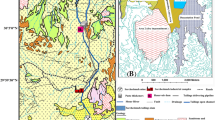Abstract
Acid mine drainage potential of flotation slurry from a tailing dam in an active copper mine (Murgul) in Turkey was evaluated using an integrated approach combining static and kinetics tests, mineralogical and geochemical characterization and geochemical modeling. Acid mine drainage potential of the tailing waste was determined by acid base accounting tests and humidity cell experiment. During ABA tests, paste pH, fizz rating, sulfur speciation, acid and neutralization potentials of the slurry were measured. The rates of metal release and mechanism were determined from the humidity cell experiment. Leachates sampled weekly from the humidity cell were monitored for their pH, electrical conductivity, oxidation–reduction potential, alkalinity, sulfate and metal contents. In addition, at the end of the experiment, cell material was sampled along the flow path to determine the possible AMD products formed. Results of the ABA tests indicated that the tailing waste exhibited acidic character. Paste pH of the waste was 4.35. Acid potential (116.5 kg CaCO3/t) of the waste was about 34-folds more than its neutralizing potential (3.44 kg CaCO3/t), indicating that tailing waste had a high acid producing potential. In contrary to the ABA tests, the results of humidity cell experiment indicated that leachates of the tailing waste exhibited neutral to alkaline pH values (pH 7.4–8.2) throughout the experiment. The rates of metal (e.g., Fe: 0.04–0.001 mg/kg/week, Cu: 0.005 mg/kg/week) and sulfate release (24 mg/kg/week) were very low. Metals in leachate showed similar elution behavior. The rates of metal release were initially fast and then decreased significantly, suggesting that different processes including desorption, mineral dissolution/precipitation and oxidation played a role on metal elution behavior. Neutral to alkaline pH values observed throughout the humidity cell experiment suggesting that acidity produced by the pyrite oxidation was buffered by the low neutralizing capacity of the waste. Low permeability of the tailing waste and the presence of the unaltered pyrite grains significantly limited the kinetics of the acid mine drainage formation. Evidence of pyrite oxidation and the formation of ferrihydrite precipitates was visible especially at surface of the waste that was in contact with air and water. Dissolution of gypsum also controlled the observed sulfate release behavior from the tailing waste. Mass balance calculations performed on each metal showed that the percentage of mass eluted from humidity cell for Mn, Zn and Cu was 8.6, 4.9 and 3.6%, respectively, while it was <1% for the rest of the metals investigated. Results of this study suggest that slow metal leaching kinetics of the tailing waste reduce the risk of metal contamination in the surrounding surface water bodies that is in contact with the waste material.










Similar content being viewed by others
References
AWWA (1995) Standard methods for the examination of water and wastewater, 19th edn. American Public Health Association (APHA), Washington, DC, ISBN 0-87553-235-7
Chotpantarat S (2011) A review of static tests and recent studies. Am J Appl Sci 8(4):400–406
Jacobs JA, Lehr JH, Testa SM (2014) Acid mine drainage, rock drainage and acid sulfate soils: causes, assessment, prediction, prevention and remediation. Wiley, Hoboken, p 520. ISBN 9780470487860
Lapakko K (2002) Metal mine rock and waste characterization tools: an overview, mining, minerals and sustainable development, Report No: 67. Acid drainage technology initiative
Lawrence RW, Wang Y (1997) Determination of neutralization potential in the prediction of acid rock drainage. In: Proceedings of 4th international conference on acid rock drainage, Vancouver, pp 449–464
MEND (1997) Guideline document for monitoring acid mine drainage. Project 4.5.4. Mine environment neutral drainage program. Project S. 185, Contract. 23440-5-1176/01-SQ, p 353
Mendez-Ortiz BA, Carrillo-Chavez A, Monroy-Fernandez MG (2007) Acid rock drainage and metal leaching from mine waste material (tailings) of a Pb–Zn–Ag skarn deposit: environmental assessment through static and kinetic laboratory tests. Revista Mexicana de Ciencias Geológicas 24:161–169
Miller FP, Vandome AF, McBrewster J (2009) Acid mine drainage. Alphascript Publishing, Aurora, p 172. ISBN 9786130263515
Morin KA, Gerencher E, Jones CE, Konasewich DE (1991) Critical literature review of acid mine drainage from waste rock, MEND Project 1.11.1, Canada, p 173
Price WA (1997) Draft guidelines and recommended methods for the prediction of metal leaching and acid rock drainage at mine sites in British Columbia. Ministry of Employment and Investment, Victoria, p 141
Sağlam ES, Akçay M (2016) Chemical and mineralogical changes of waste and tailings from Murgul Cu deposits (Artvin, NE Turkey): implications for occurrence of acid mine drainage. Environ Sci Pollut Res 23:6584–6607
Sobek A, Schuller W, Freeman J, Smith R (1978) Field and laboratory methods applicable to overburdens and mine soil. US Environmental Protection Agency, Washington, DC, EPA/600/2-78/054 (NTIS PB280495)
USEPA (1994) Acid mine drainage prediction, US Environmental Protection Agency, Office of Solid Waste, Special Wastes Branch (Washington, DC), EPA 530-R-94-036
Yolcubal I, Doğrul-Demiray A, Çiftçi E, Sanğu E (2016) Environmental impact of mining activities on surface water and sediment qualities around Murgul copper mine, Northeastern Turkey. Environ Earth Sci 75:1415. doi:10.1007/s12665-016-6224-y
Zhang YL, Evangelou VP (1996) Influence of iron oxide forming conditions on pyrite oxidation. Soil Sci 161(12):852–864
Acknowledgements
This research was supported by a grant 110Y0235 provided by The Scientific and Technological Research Council of Turkey (TUBİTAK). We thank anonymous reviewers for their constructive comments.
Author information
Authors and Affiliations
Corresponding author
Rights and permissions
About this article
Cite this article
Yolcubal, I., Demiray, A.D. & Çiftçi, E. Assessment of acid mine drainage potential of flotation slurry from a tailing dam in a copper mine, Murgul, Northeastern Turkey. Environ Earth Sci 76, 100 (2017). https://doi.org/10.1007/s12665-017-6423-1
Received:
Accepted:
Published:
DOI: https://doi.org/10.1007/s12665-017-6423-1




